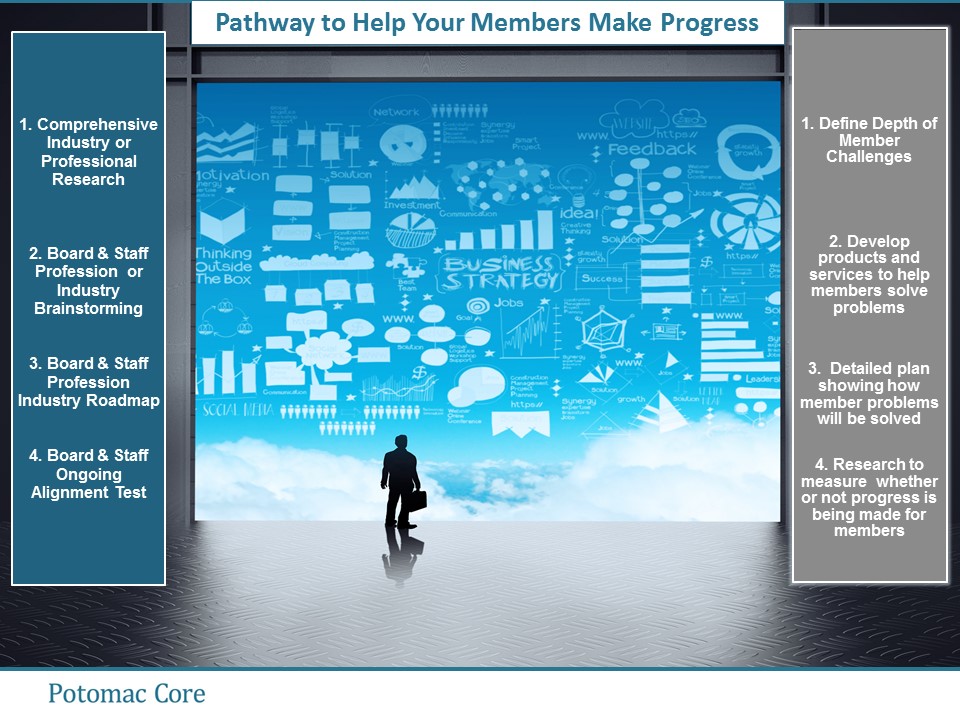Members hire Associations, Members fire Associations is what the new mantra will be for Association Executives in 2018. The evolving external environment is continually redefining how member executives assess the impact of their memberships. At year end 2017, Association Executives would find it useful to see the world as their members do and understand what help they need to make progress in their Industry or Profession. While economists forecast a brighter global growth picture, your members still face a myriad of uncertainty. Cyber & nuclear threats, disruptive innovation, and increasing competition for market share will continue to reshape how members view their memberships. This means organizations will require new and different external research to understand what tools they must provide in order to help their members make progress.
Members Hire Associations, Members Fire Associations
Since the end of the great recession, Boards are helping their Associations see the world as they see it. Pushing an all you can eat buffet as your value proposition is now the dark ages. Even connectivity to business and professional challenges and providing immediate solutions represent a smaller fraction of evolving member expectations. In other words, if your Association is not perceived as a vehicle to help drive progress for your members and prospective members then your organization:
- Will likely be fired by your members.
- Will not be hired by your prospective members.
In 2018 the new mantra will be: Members hire Associations, Members fire Associations.
Research Keeps Associations Connected to Member Problems that Need to Be Solved
For organizational CEO’s embracing the new marketplace that Members hire Associations, Members fire Associations you’ve taken an important first step. As Boards insist upon more operational rigor at their Associations, they are turning to externally focused and segmented research. This data is playing an increasingly important role in strategic planning and product development. In several cases, Association CEO’s are assessing strategies, products, & services as for profit executives do at global enterprises.
The National Association of Independent Schools
NAIS is a nonprofit membership association that provides services to more than 1,800 schools and associations of schools in the United States and abroad, including more than 1,500 independent private K-12 schools in the U.S.
 As the new NAIS President, Donna Orem, her Board, and her team set out to build a segmented research study to profile the market of Private Schools. Their research identified four segments in their marketplace. What they learned was how each segment differs in terms of goals they hope to achieve, professional needs, and demographic characteristics. While each segment presented different implications, NAIS leveraged Board guidance and took to address the differences in each member segment. This work only took them so far, however. After learning from a board member about the Jobs To Be Done framework, the board and leadership team agreed that this approach, which explores what causes someone to hire or fire a product or service, could provide even more actionable insights.
As the new NAIS President, Donna Orem, her Board, and her team set out to build a segmented research study to profile the market of Private Schools. Their research identified four segments in their marketplace. What they learned was how each segment differs in terms of goals they hope to achieve, professional needs, and demographic characteristics. While each segment presented different implications, NAIS leveraged Board guidance and took to address the differences in each member segment. This work only took them so far, however. After learning from a board member about the Jobs To Be Done framework, the board and leadership team agreed that this approach, which explores what causes someone to hire or fire a product or service, could provide even more actionable insights.
“Jobs to Be Done” Approach
Harvard Professor Clayton M. Christiansen has researched what makes businesses successful in his over twenty years of teaching at Harvard Business School. He is most well known for creating the theory of Disruptive Innovation. He put forth the “Jobs To Be Done” Approach in his recent book Competing Against Luck. The underlying premise is that in today’s marketplace “people no longer buy products or services. Instead they hire them to make progress.” The NAIS team utilized this approach to develop value propositions that addressed the struggles that heads of schools and administrators face and to understand how those struggles change as they progress through their careers.
The process changed the way the organization and the Board develops and delivers value to their members, and redefined how the Association thinks from strategy through implementation.
NAIS is already utilizing their newly minted strategies to retain and acquire new members and accordingly Donna Orem notes, “We found the JTBD work to be transformational.”
Club Managers Association of America
The Club Managers Association of America (CMAA) is the professional Association for managers of membership clubs. CMAA has close to 6,700 members across all classifications.
 For Jeff Morgan & his team, it’s imperative to have a business minded research systematic approach in product management and strategy. They utilize approaches developed management consulting firms including the Boston Consulting Group, McKinsey, Ansoff, and Blue Ocean Strategy. Their assessment process helps the CMAA team reach a “problems to be solved” determination on each of their products:
For Jeff Morgan & his team, it’s imperative to have a business minded research systematic approach in product management and strategy. They utilize approaches developed management consulting firms including the Boston Consulting Group, McKinsey, Ansoff, and Blue Ocean Strategy. Their assessment process helps the CMAA team reach a “problems to be solved” determination on each of their products:
- Ensure the Association is serving its members (Mission)
- Make better (supportable) strategic decisions
- Help to prune portfolio of products to make room for new ones
- Improve internal resource allocation
- Product-lifecycle focus
- Strategy alignment (internally/externally)
These steps have helped CMAA deliver increased strategic and operational rigor to their product management approaches. The process has been “an integral part of how the organization delivers increasing value to Club Management Professionals at each stage of their careers.”
American Bakers Association
The American Bakers Association (ABA) is the Washington D.C. based voice of the wholesale baking industry. ABA represents the interests of bakers before the U.S. Congress, federal agencies, and international regulatory authorities. ABA advocates on behalf of more than 1,000 baking facilities and baking company suppliers.
 Robb MacKie, President & CEO sees the Baking Industry experiencing unprecedented disruption and evolving consumer attitudes. Determined to identify a “problems to be solved approach,” they launched a research based strategic planning process. What’s different about it is how the process is geared toward an external perspective of business challenges and how ABA could accelerate its impact on all segments of the Baking Industry. The Association also seeks to determine how they can continually increase their alignment with the Industry they serve.
Robb MacKie, President & CEO sees the Baking Industry experiencing unprecedented disruption and evolving consumer attitudes. Determined to identify a “problems to be solved approach,” they launched a research based strategic planning process. What’s different about it is how the process is geared toward an external perspective of business challenges and how ABA could accelerate its impact on all segments of the Baking Industry. The Association also seeks to determine how they can continually increase their alignment with the Industry they serve.
Similar to NAIS and CMAA, ABA’s business focus is drawn partially from leading business authors including Chris Zook, “Profit From The Core. Growth Strategy In An Era of Turbulence.” Through this process Robb Mackie, the Board, and the Senior Team have surfaced & identified the core challenges and problems to be solved for the Industry today. Their focus is to build a new and more nimble strategy that continually aligns ABA with the Baking Industry.
Part of ABA’s Operational Rigor includes an evaluation and assessment planning process to ensure that the organization is best positioned to address & solve Industry problems for the members:
- Sunsetting process to identify their noncore products
- Operational Readiness Assessment on existing & New Core Products
- Developing Metrics to measure new product & service impact on Industry Business & Growth Challenges
Because of externally focused and segmented research, NAIS, CMAA, and ABA have greater understanding into what’s next for Associations, Members Hire Associations, Members Fire Associations.
Ongoing Alignment Test: Members Hire Associations, Members Fire Associations
Part of the next evolution of Association strategic planning and product development is how externally focused and segmented research is driving strategy and implementation to help members solve their problems.
 Earlier this year, NPES launched an ambitious strategic plan to align and grow the global printing and imaging Industry. As part of its strategic overhaul Thayer Long, President, is focusing the organization to more quickly and readily adapt to emerging Industry challenges. He sees ongoing research as necessary to maintain ongoing alignment with the members. Through ongoing research NPES is increasing its understanding of why members hire/fire Associations. For example, the Association now:
Earlier this year, NPES launched an ambitious strategic plan to align and grow the global printing and imaging Industry. As part of its strategic overhaul Thayer Long, President, is focusing the organization to more quickly and readily adapt to emerging Industry challenges. He sees ongoing research as necessary to maintain ongoing alignment with the members. Through ongoing research NPES is increasing its understanding of why members hire/fire Associations. For example, the Association now:
- Maintains an Alignment dashboard focused on Industry performance.
- Conducts an annual Industry Alignment survey research to measure its impact on the problems that need to be solved.
Having this additional research will help NPES and other organizations who are embracing the new reality: Members hire Associations, Members fire Associations.
Members Hire Associations, Members Fire Associations
Strategic planning and product development are rapidly changing. These are not just one time exercises. Instead, its ongoing research that will continually help to identify member problems that need to be solved. It’s more comprehensive and it requires drilling down through segmented qualitative and quantitative research to surface the member problems that need to be solved. This is a four step process that will position Associations to drive ongoing progress for its members:

As the curtain rises in 2018 the new reality is Members hire Associations, Members fire Associations. Adjusting to the new reality requires externally focused and segmented research that helps your organization understand what help members need in order to make progress. Welcome to 2018: Members hire Associations, Members fire Associations.
To learn more about how your Association can build a potent pathway to progress click here.





